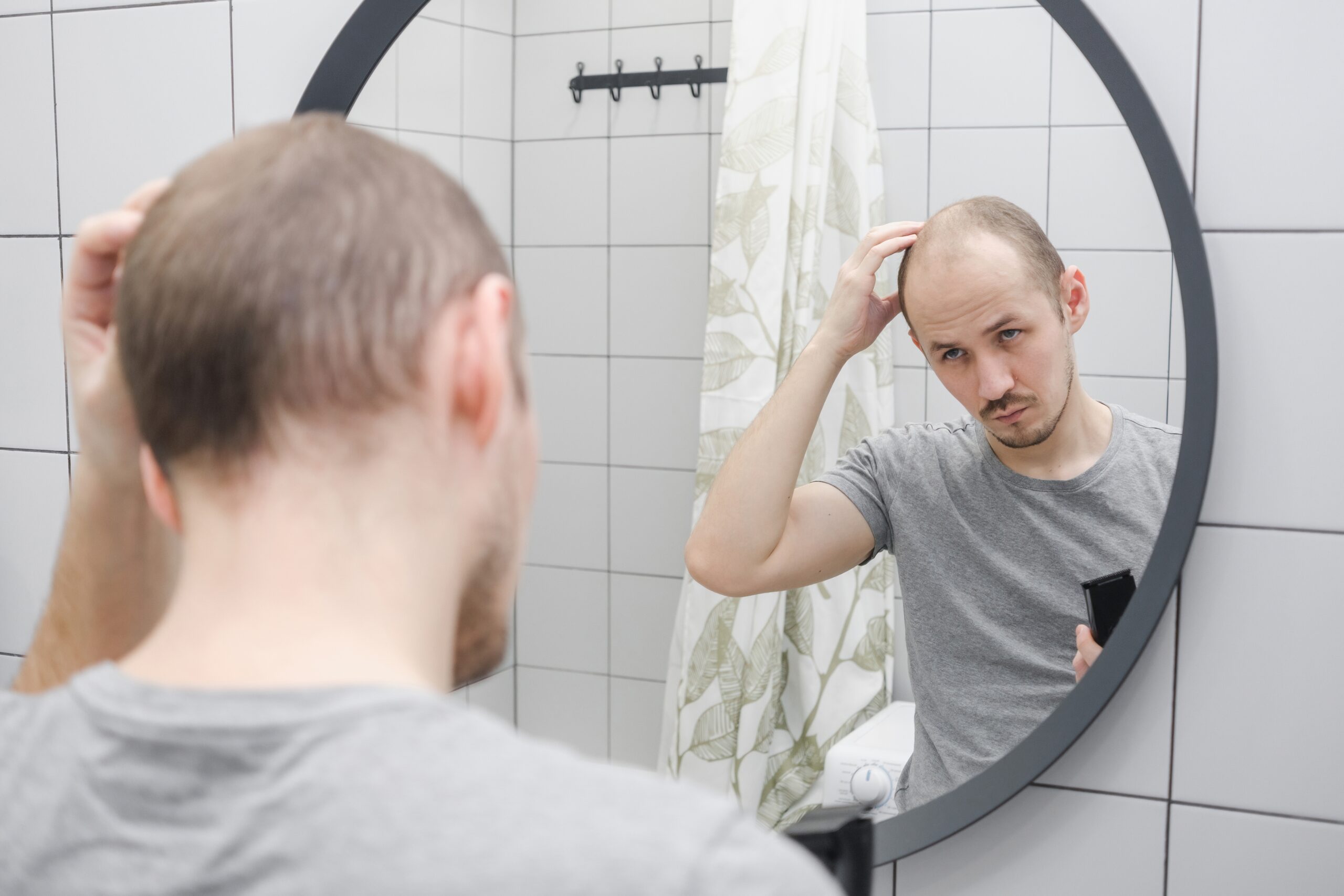Medical Management of Alopecia
Frequently asked
Questions
Why am I losing my hair?
The causes of alopecia and their frequencies vary according to gender:
Men:
- Genetic predisposition (androgenetic alopecia), where the follicles at the top of the head become sensitive to DHT, a hormone derived from testosterone.
- Physiological shock (diseases) or psychological shock (stress, anxiety, depression).
Women:
- Genetic predisposition and physiological/psychological stressors, as in men.
- Hormonal changes found, for example, in postpartum or in peri and post menopause (women with androgenic alopecia are particularly vulnerable during these periods of life).
- Malnutrition and restrictive diets that lead to deficiencies in micronutrients such as iron, vitamin D or biotin.
- Hypo or hyperthyroidism
- Deterioration of hair follicles following prolonged traction or due to chemical agents (relaxing, perms, etc.)
As much in men as in women, we sometimes find, among the causes of alopecia, some rare diseases of inflammatory/autoimmune origin (e.g., alopecia areata and cicatricial alopecia). When the clinical evaluation suggests this type of alopecia, a dermatology referral may be necessary to clarify the diagnosis and optimize management.
Are there medical treatments to stabilize androgenetic baldness?
The first-line medical treatment options, based on scientific evidence, that we recommend are:
- Platelet-rich plasma (PRP): the star treatment of our clinic.
- Platelets play an important role in tissue regeneration. They are mainly used to stop bleeding when the body suffers an injury. Once the clot is in place and the bleeding has stopped, the platelets release many growth factors that will stimulate the repair and regeneration of damaged tissues. PRP takes advantage of this communication pathway to protect and, in some cases, regenerate follicles that are highly receptive to these growth factors.
- This treatment involves taking a few milliliters of blood, from which the plasma containing the platelets in greater concentration will be extracted by centrifugation. This plasma enriched with platelets is reinjected by micropuncture into the affected scalp and the platelets will immediately release their growth factors. These platelet growth factors awaken and normalize the follicular cycle, protect the hair from DHT and improve its quality.
- Our PRP treatment protocol also includes a biostimulation laser session and a vitamin infusion on the scalp. It requires an initial cycle of 4 treatments, once a month for 4 consecutive months, and a maintenance phase with 1 treatment every 4 to 6 months. It is recommended to avoid non-steroidal anti-inflammatory drugs for 2 weeks before each treatment (e.g., Aspirin, ibuprofen, naproxen). The PRP protocol can be adapted in several ways depending on the patient's needs and can be combined with neuromodulators (e.g., Botox) for excessive scalp sweating or with dutasteride in mesotherapy (micro-injections) according to medical evaluation, the goal always being the stabilization and maintenance of existing hair.
- Anti-DHT agents. Finasteride or dutasteride block the enzyme that converts testosterone to DHT. The daily intake of these drugs reduces tissue levels of DHT, thus protecting sensitive follicles. Side effects are rare and mostly sexual in nature, the most common being reduced libido in only 3-5% of cases. Finasteride is a treatment option in women only at menopause because of the risk of fetal malformation when the drug is taken during pregnancy. Other hormonal protection strategies for women with androgenetic alopecia include spironolactone (a diuretic with anti-androgenic action) and bioidentical hormones.
- Minoxidil 5% (Rogaine). Minoxidil is an old antihypertensive drug which also activate the microcirculation of the scalp and the follicular cycle. The topical treatment in the form of a foam is available without a prescription and is applied twice a day in men and once a day in women. For patients who do not tolerate or respond to the topical formulation, a low dose of the oral medication may then be prescribed.
- Biostimulation lasers. These lasers emit waves in the infrared light spectrum that activate microcirculation and tissue regeneration. The protocols vary according to the companies but generally involve 2 to 3 sessions of 30 minutes per week.
Studies have shown that the combination of several treatment modalities offers significantly better results. All the therapeutic options listed above can therefore be combined to optimize the results.
Once my alopecia has stabilized, how can I densify the hair that I have lost?
Medical stabilization of alopecia sometimes makes it possible to densify the areas recently affected by baldness, but hair lost for many years is often lost forever. For good candidates, bald or sparse areas of the scalp can be filled in and thickened with follicular unit transplantation ( hair transplantation). The procedure is performed under local anesthesia with light sedation. One to two sessions may be required depending on the number of follicular units needed. Recovery is rapid and the results, which will be permanent, are visible after approximately 6 to 12 months.
Are there other things I can do to optimize my results?
Your treatment plan could also include lifestyle changes to promote a balanced diet, better stress/anxiety management, exercise, a multivitamin supplement (Centrum, Materna). For most cases, alopecia is a chronic and progressive condition. Medical therapy stabilizes hair loss in most cases and significantly slows its progression. A good follow-up and a partnership with your doctor and your hair restoration technicians will therefore be essential to maintaining your hair in the long term.

